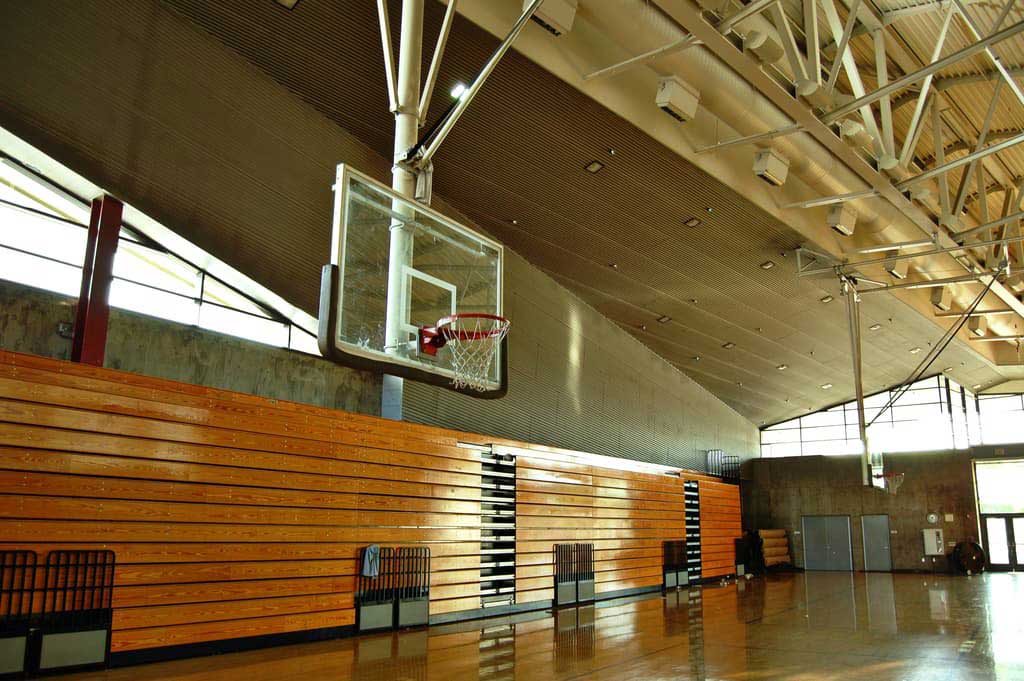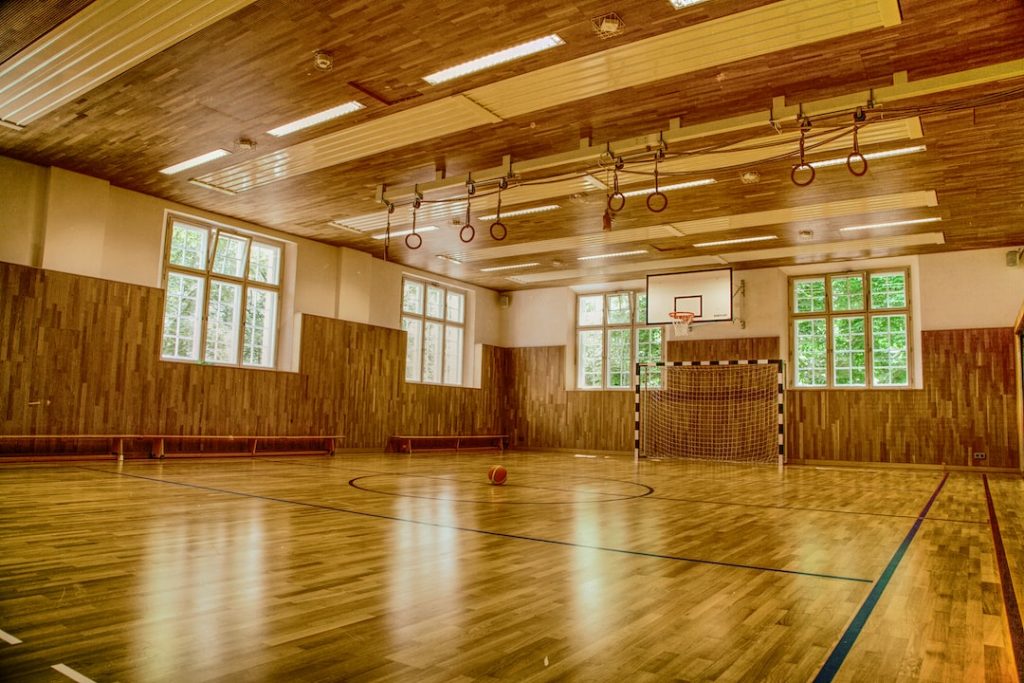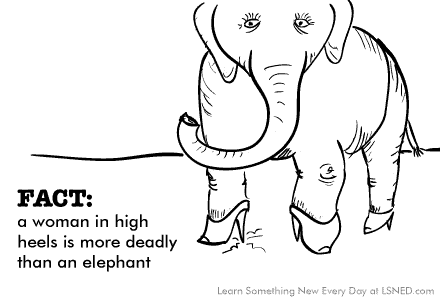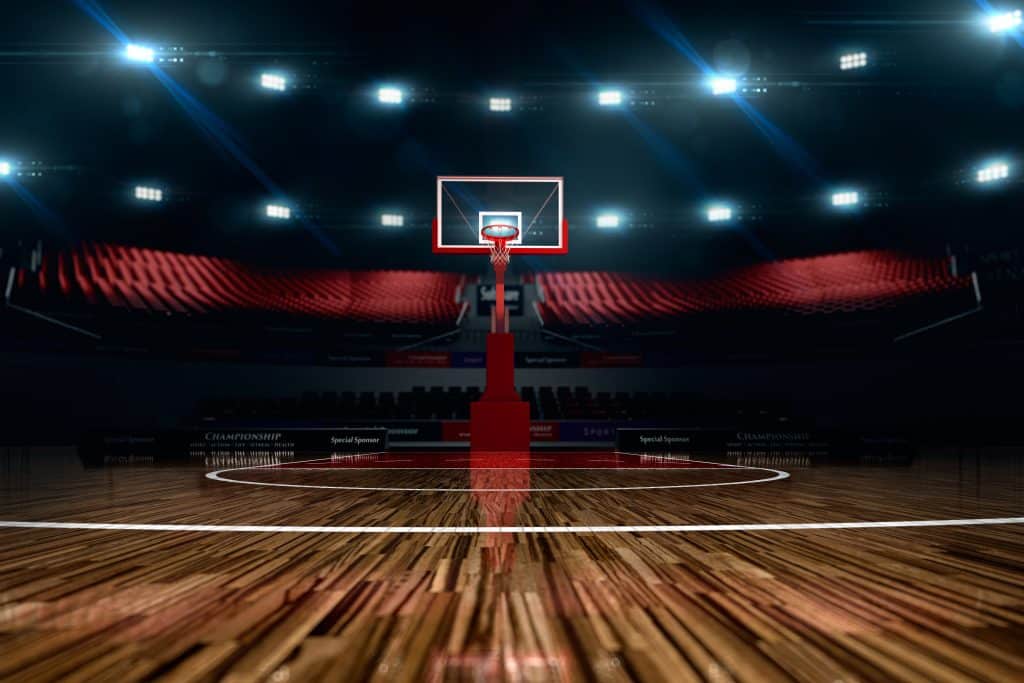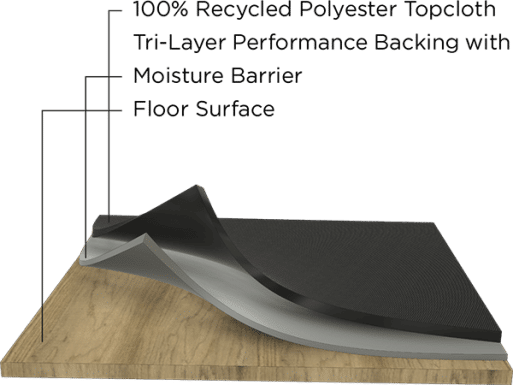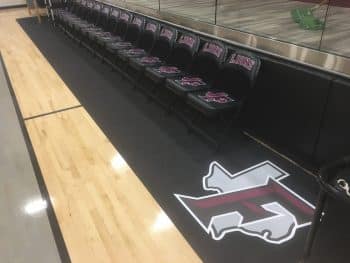The expense of Gym Floor Damage: Ways to Avoid It
A gym floor is a major capital investment and understanding what potential damage can occur can give you the key information to be proactive in keeping your gym floor looking great and functioning well for many years.
Read on to see:
- How long should a gym floor last?
- What causes gym floor damage?
- How to protect your gym floor from winter damage?
- How do I maintain my gym floor finish?
- How much does it cost to refinish or replace a gym floor?
- How often does a gym floor need to be replaced?
- What damage can happen to a Hardwood Maple Sports Floor System and how can it be reversed?
- How do gym floor covers help to protect gym floors?
How long should a gym floor last?
The lifespan of gym floors can vary depending on the type of gym floor cover used and how it is maintained.
Generally, gym floors using synthetic gym floor covers can last from 3 to 5 years with proper maintenance.
On the other hand, gym floors using hardwood gym floor covers can last anywhere from 7 to 10 years, to as many as 35 years with regular upkeep.
Gym owners and managers need to inspect their gym floors regularly for signs of damage and wear and tear to extend their lifetime and minimize replacement costs.
Additionally, gym owners and managers should use quality gym mats or pads to protect the gym floor cover from heavy traffic or excessive weight loads to reduce damage over time.
With good care and maintenance, gym owners or managers can maximize the lifespan of their gym flooring and enjoy a gym space that looks great and stands the test of time.
What causes gym floor damage?
Gym floor damage can be caused by a variety of things, including heavy gym equipment, incorrect cleaning and maintenance practices, and even the wrong type of gym shoe, or street shoe wear and tear.
Heavy gym equipment placed on gym floors can cause indentations or scratches when moved around without taking proper precautions.
Incorrect cleaning and maintenance practices such as using too harsh chemicals or abrasive scrubbing pads can also damage gym floors.
Finally, gym shoes with metal spikes, sharp cleats, or other rough edges may scratch or puncture gym floors if not worn properly.
Street shoes are also an issue due to the scuffs, scratches and gouges that occur, especially if someone has high heels on.
It’s important to consider all these factors when looking for ways to prevent gym floor damage and ensure your gym remains in top condition.
Additionally, gym owners and staff should take the time to regularly inspect gym floors for any signs of damage.
By catching gym floor damage early on, gym owners can ensure that it is addressed promptly before it causes further harm or becomes expensive to repair.
With a little extra effort, gym owners can maintain their gym without having to worry about expensive repair bills due to avoidable damages.
Investing in gym floor protection now can save gym owners money and stress later on, so be sure to take preventive measures before any damage occurs!
How to Protect Your Gym Floor from Winter Damage?
The winter season can wreak havoc on gym floors, causing costly damage to your gym’s infrastructure.
Gym floors can suffer from wear and tear during the winter months due to a variety of reasons.
Snow and rain can cause moisture to accumulate on gym floors, which can soften the surface and lead to indentations or divots in the gym flooring.
Harder winter temperatures can also cause gym floor surfaces to contract or expand, leading to instability and cracking of the gym floor.
In addition, ice melter that is used on outdoor gym surfaces can corrode gym floor finishes if it isn’t removed promptly after application.
To protect gym floors during cold weather conditions, gym owners should ensure that snow and ice are cleared away quickly to reduce moisture levels.
To help protect your gym floor from the harm of winter weather, we’ve compiled a few simple tips:
- Heavy-duty entrance mats are an essential gym accessory to help protect gym floors from dirt, debris, and moisture.
They act as a barrier between the gym floor and gym-goers’ shoes and clothing, helping keep gym floors free of dirt and other contaminants that can damage their surface.
The mats also trap moisture, preventing them from seeping into the gym floor and causing warping or discoloration.
In addition to protecting gym floors, heavy-duty entrance mats provide cushioning for gym-goers when they enter the facility, helping reduce fatigue and reducing the risk of slips and falls.
Investing in high-quality heavy-duty entrance mats is a great way to ensure your gym’s safety while preserving its beauty.
2. Regular roofing inspections are essential for gym owners to help protect the gym floor from water damage.
A regular inspection should include checking for loose shingles, worn-out flashing, and other sources of potential leaks.
These areas should be repaired as soon as possible to ensure that gym floors remain dry and secure.
If a gym floor is allowed to stay wet due to water damage, it can become unstable and dangerous for gym goers.
Regular roofing inspections can prevent this type of hazard by keeping gym floors safe and dry.
Investing in periodic roof inspections will save gym owners time and money in the long run by protecting their valuable gym floor from unnecessary water damage.
3. Gym floors can be vulnerable to damage when exposed to extreme temperature variations.
Regular HVAC inspections are essential for gym owners and facility managers to ensure the gym floor is properly maintained.
Without a proper inspection, gym floors can become damaged or deteriorate over time due to excessive heat or cold temperatures in the gym environment.
This can be especially problematic if the gym flooring is made of wood, which is vulnerable to warping and cracking when exposed to extreme temperature variations.
Regular HVAC inspections help detect problems before they cause damage and lead to costly repairs down the road.
Additionally, regular inspections also help keep gym occupants safe by making sure all parts of the HVAC system are working correctly and not releasing unhealthy air.
By investing in regular preventative maintenance, gym owners can ensure their gym floors remain in top condition for years to come.
The dry winter air can wreak havoc on gym floors made of maple.
If a gym floor is not properly maintained, the wood will shrink due to the decrease in humidity and can cause gaps between each board.
This can leave spaces for dirt and other debris to accumulate, which could lead to more serious damage over time.
Additionally, if the gym floor is left untreated, it may become brittle and start to splinter or crack.
To prevent such issues from occurring, gym owners should take steps to properly care for their maple gym floor.
- The first step is to maintain proper humidity levels in the gym space. Install a humidistat designed for gym floors so that you can control exactly how much humidity is present at all times.
Maintaining an optimum humidity level is key for gym floors.
Too much moisture can cause damage to gym flooring, like warping or cracking, while too little can lead to a loss of grip and potential slips and falls.
For gym floors in particular, the ideal humidity levels to maintain are between 35-45% relative humidity (RH).
Maintaining this range ensures that gym floors remain at peak performance about safety and durability.
Regularly checking relative humidity levels should be part of any gym’s maintenance routine.
For best results, use a quality digital hygrometer that accurately measures temperature and relative humidity levels in real time.
This will allow gym operators to better understand their environment and identify potential problems before they become too severe.
2. Maintaining the gym floor at an optimal temperature is critical for preserving the gym floor, gym equipment and keeping gym-goers safe.
Generally, gym floors should be kept between 60°F and 80°F to prevent damage or discomfort caused by extreme temperatures.
This range also allows gym-goers to exercise in a comfortable environment that is conducive to physical activity.
Additionally, humidity levels should be kept low (below 55%) to reduce the chances of slipping and falling on the gym floor.
By having a consistent maintenance regimen and understanding the importance of optimum humidity levels, gym owners can ensure that their gym floor remains safe and in top condition for years to come.
Taking proactive measures to maintain gym floors will help gym operators save time, money, and energy in the long run and prevent gym floor damage.
3. Additionally, gym owners should take care to clean and wax their gym floor regularly to protect it from dirt, dust, and other debris.
Doing so can help keep the wood sealed and prevent it from shrinking or cracking due to dry air.
Taking these steps will ensure that your gym floor is protected from dry winter air and can stay in good condition for years to come.
What damage can happen to a Hardwood Maple Sports Floor System and how can it be reversed?
A good Hardwood Maple gym floor system should last up to 35 years or even 40 to 50 years with diligent maintenance.
Maintaining the correct humidity will help to keep floorboard separation at a minimum.
The nature of maple allows for the normal expansion and contraction of wood, as you would see in any wood floor or piece of furniture.
As with installed hardwood in homes and other commercial facilities, expansion joints allow for normal flooring expansion.
Cupping can occur, which is the board raising on the edges. This is often due to a moisture issue.
Work quickly to find the source of the moisture and eliminate it. If left too long, your flooring may not recover.
Crowning is the reverse of cupping, as the board will raise in the center and be distorted. Again, moisture is the issue.
Always allow time for the moisture level to even out and hopefully revert to its original shape.
Buckling is the most severe damage and this occurs if major water covers the floor and is not immediately addressed.
The boards will swell and cause the gym floor to raise, drastically changing the angle of your gym floor.
Though this is a drastic issue, if caught in time it can be sanded down and blemishes addressed.
If not caught in time, you’ll have to replace your gym floor.
Above all else, maintain your gym floor to ensure its longevity and a safe gym environment for all.
Prevention is always better than cure!
If you ever have any doubts as to what may be causing damage or issues with your gym floor, call in a professional who can offer their expertise on the matter.
Hardwood gym floors are exposed to a lot of wear and tear.
Maple gym floors, in particular, can be susceptible to gym floor damage from heavy usage, extreme environmental conditions, and inadequate cleaning.
Common types of gym floor damage that maple gym floors can incur include scratches, dents, gouges, discoloration, warping, cupping, and splits.
- Scratches are caused by shoes dragging across the floor’s surface while walking or running
- Dents occur when objects such as weights or furniture are dropped on the floor
- Gouges happen when sharp objects like cleats scrape into the gym floor
- Discolored spots come from liquid spills that aren’t cleaned up quickly enough
- Warping is caused by changes in humidity levels
- Cupping usually occurs when there is a moisture issue
- Splits may be caused by large objects that are dragged across the gym floor.
Although most of these types of damage can be repaired, gym owners should try to prevent them in the first place.
Regular cleaning and proper maintenance of gym floors can go a long way in keeping maple gym floors looking great.
Daily Maintenance Routine:
Even if your maple gym floor is not used everyday, your maintenance staff should still be performing daily maintenance as recommended by MFMA include:
- Sweep/dry mop the floor using a properly treated dust mop (Courts that are used frequently can be dry mopped as much as three times daily)
- Immediately wipe up any spills or moisture on the sports floor
- Check the HVAC system to make sure it is functioning properly
- Inspect the floor for signs of damage, including tightening or shrinkage
- Check for water leakage
- Remove debris from expansion voids
The MFMA says facility owners and maintenance crews should avoid the following:
- Never shutdown the HVAC for prolonged periods unless absolutely necessary
- Never clean maple sports floors with scrubbing machinery or power scrubbers
- Never use household cleaning products on your sports floor as it could harm the finish
Always check with your sports flooring manufacturer or installer for the best cleaning products to use on your floor.
*If you have damage contact your installer or manufacturer right away for advice on minimizing the damage and handling the repairs to the damage.
How do you maintain a gym floor?
Maintaining a gym floor is an important part of keeping your workout environment safe and clean.
Gym floors are prone to wear, tear, and damage from heavy weights and high-impact activities such as running or boot camp classes.
To prolong the life of your gym floor, regular cleaning and maintenance should be done regularly.
Daily cleaning is essential for removing dirt, dust, and sweat that can build up in between exercise equipment and on the floor surface.
This can help prevent slips and falls caused by slippery surfaces.
Sweeping or vacuuming the gym floor regularly will help remove debris that may have accumulated throughout the day.
A damp mop can also be used to pick up any additional dirt that has been left behind from daily use.
For gym floors with synthetic surfaces, periodic stripping and waxing should be done to keep the gym floor looking its best.
This will help protect the surface from damage and wear caused by heavy weights or high-impact activities.
Additionally, gym mats should be used under exercise equipment to further protect the gym floor from potential scratches or gouges.
By following these easy steps, gym owners can ensure their gym floors look great for years to come.
Regular maintenance is essential for maintaining a safe and clean workout environment for all gym users!
How much does it cost to refinish or replace a gym floor?
The cost of gym floor refinishing or replacement depends on the size of the gym, the type of gym floor, and the condition of the existing gym floor and how much gym floor damage has occurred.
Refinishing may be cheaper than replacing in some cases.
On average, it can cost between $3 – $6 per square foot for gym floor refinishing and up to $11 – $14 per square foot for gym floor replacement.
For a typical gym with 5000 sq ft of gym space, this could add up to a total cost between $15,000 and $35,000.
Additionally, it may be necessary to obtain permits to perform work on gym floors depending on local regulations.
Therefore it is important to factor in any applicable additional costs when considering either refinishing or replacing gym flooring.
Overall, gym floor refinishing or replacing can be a significant expense for gym owners and gym managers; however, it is often necessary to maintain or upgrade the gym’s aesthetic and safety standards.
By taking into account all of the potential costs associated with gym flooring refurbishment or replacement, gym owners and gym managers can ensure that their gym remains safe and up-to-date.
How often does a gym floor need to be replaced?
Typically, gym flooring needs to be replaced every eight years, but excellent maintenance and care has kept maple gym floors functioning for up to 35 years or more.
However, this timeline can vary depending on the type of gym flooring used and how it is maintained.
High-quality gym flooring can last a few more years if it is installed properly and well cared for.
Regular maintenance is essential to extend the life of gym flooring.
This includes sweeping or vacuuming at least once a day, mopping as needed, and cleaning up any spills or messes immediately.
Additionally, gym floor mats should be placed in high-traffic areas to help protect the surface from wear and tear.
If gym floors are not routinely cleaned and maintained, they will need to be replaced sooner than expected.
When replacing gym floors, it is important to select gym flooring that can withstand the wear and tear of regular gym use.
Choosing gym flooring with a high level of durability will help ensure it lasts as long as possible.
Overall, gym flooring should be replaced every eight years, but proper maintenance and care can help extend its life.
How do gym floor covers help to protect gym floors?
Gym floor covers are essential for gym owners looking to protect their gym floors from damage.
They provide a layer of protection between the gym floor finish and foot traffic, chairs, tables, and various equipment used when the gymnasium is converted to other activities.
Gym floor covers also help protect gym floors from dirt and moisture that can be brought in through people’s shoes.
The coverings act as a barrier, helping to prevent these substances from coming into contact with the gym floor.
By keeping gym floors clean and dry, gym floor covers extend the life of gym floor finishes.
They also help to reduce gym maintenance costs by reducing the need for frequent gym cleaning and repairs.
Ultimately, gym floor covers can help gym owners keep their gym floors looking great for longer periods.
Consequently, gym owners should consider investing in quality gym floor covers if they are looking for a practical solution to protect their gym floors from damage during multipurpose activities.
The combination of a good gym floor cover during activities in the gym and a diligent maintenance routine will keep your gym floor looking and functioning great for many years.
CONTACT Enhance Mats for your new gym floor cover.
Choosing the best gym floor cover system with the best storage rack for your school or facility takes selecting the right company.
Check out our videos on the roll, tile, and courtside runner pages to see all of the key points you need to know to make the best decision.
Enhance Mats offers roll systems in both 6’ and 8’ widths, heavy duty tile systems, custom color tiles and courtside runners to protect your gym floor.
Trust Enhance Mats, the leader in Sports Surface Protection to help your choose the right gym floor cover system for your facility. Call 877-318-8625 or Request a Quote today!

